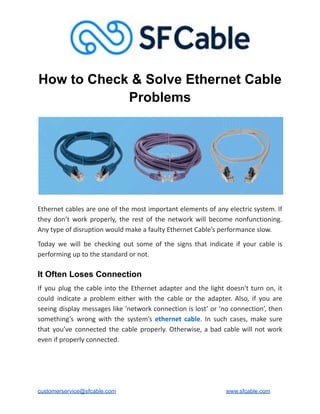
How to Check & Solve Ethernet Cable Problems.pdf
- 1. How to Check & Solve Ethernet Cable Problems Ethernet cables are one of the most important elements of any electric system. If they don’t work properly, the rest of the network will become nonfunctioning. Any type of disruption would make a faulty Ethernet Cable’s performance slow. Today we will be checking out some of the signs that indicate if your cable is performing up to the standard or not. It Often Loses Connection If you plug the cable into the Ethernet adapter and the light doesn't turn on, it could indicate a problem either with the cable or the adapter. Also, if you are seeing display messages like ‘network connection is lost’ or ‘no connection’, then something’s wrong with the system’s ethernet cable. In such cases, make sure that you’ve connected the cable properly. Otherwise, a bad cable will not work even if properly connected. customerservice@sfcable.com www.sfcable.com
- 2. You Always Have Slow Connection If your connection keeps dropping or runs very slowly, there are chances that you have a damaged cable. If there is a tear on your cable, it can break down the internal wire connection and can cause a short circuit. If you find a bent cable, try straightening it with your hands. In case it is too beat up, you will need to replace it. Connection Restored With A Wiggle Wiggling the cable re-establishes a failed connection. If you do this too often, it also means that you have a broken connector on your hands. Ethernet cables have a built-in plastic lever that secures the cable into place within the Ethernet adapter port. If this lever breaks, the connection will drop. Do You Keep Replacing Them? This is the ultimate sign that you need to check your network ecosystem. If replacing the ethernet cable eliminates the problem, then it’s well and good. But if the same problem persists with the new cable, the problem relates to the network. There could be some malfunction happening. In such cases, there are three types of network cable issues you should look for: Testing Connectivity Issues These issues are major because of a faulty cable. Consider taking a quick test to check the connectivity. To check, try plugging the suspected cable into the network device or network connector of another computer. Typically, the customerservice@sfcable.com www.sfcable.com
- 3. jack you plug the cable into is part of a network adapter. It provides the interface between a computer/ network device and the network cable. These adapters have one or two LED lights which state that an established connection exists and transmission is happening on the line. After you plug the cable into the network adapter, the link LED should be on to indicate a connection. If it doesn't light up or flash, there might be a problem with the cable or its connector or both of them. Testing Performance Issues If your connection is failing or transmitting data at much slower speeds, you have performance-related issues. This generally happens due to a damaged or bent cable. Usually, you can straighten a bent cable to solve the problem. And if the problem persists, you might have to replace the damaged cable. To troubleshoot, visually scan the length of the cable and look for sharp bends, kinks, or other physical faults in the cable. If you find a sharp bend or kink in the cable, straighten the cable and check if the problem is solved. Before replacing it make sure to shake the cable lightly at the connector side to see if the connection can be re-established. If so, then the problem is with the connector. Which also means that you need to repair or replace the entire cable. Testing Continuity Issues If there are any faulty connectors or bends in a cable, continuity issues can occur. They can also occur by a cut or a sliced cable, any kind of penetration by objects like a nail, staple, screw, etc., or electromagnetic interference. If you can visually scan the cable length, check for any of these causes. If not, test it with a continuity customerservice@sfcable.com www.sfcable.com
- 4. tester. An electronic device is specially made for this purpose. Such a device can help detect problems caused by EMI, or radio frequency interference. Still, Got Problems? Even after doing all this if your network keeps failing, it is very likely that issues are with local network configuration, one or more of the network connectivity devices. Like adapters, switches, routers, and so on. Such faults will require a higher level of troubleshooting. If you are looking to buy new ethernet cables, you can navigate to our ethernet networking cables page from here. From Cat 5E cable, Cat6A cable to Cat 8 cable, we have all the cables to fulfill your requirements. An Original Article Published Here: https://www.sfcable.com/blog/how-check-solve-ethernet-cable-problems customerservice@sfcable.com www.sfcable.com
